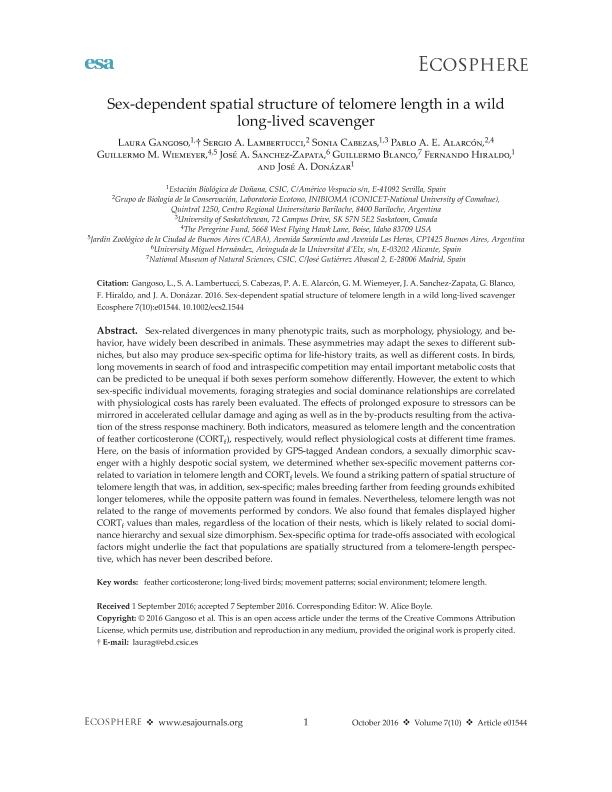Artículo
Sex-dependent spatial structure of telomere length in a wild long-lived scavenger
Gangoso, Laura; Lambertucci, Sergio Agustin ; Cabezas, Sonia; Alarcón, Pablo Angel Eduardo
; Cabezas, Sonia; Alarcón, Pablo Angel Eduardo ; Wiemeyer, Guillermo; Sanchez-Zapata, José A.; Blanco, Guillermo; Hiraldo, Fernando; Donázar, José A.
; Wiemeyer, Guillermo; Sanchez-Zapata, José A.; Blanco, Guillermo; Hiraldo, Fernando; Donázar, José A.
 ; Cabezas, Sonia; Alarcón, Pablo Angel Eduardo
; Cabezas, Sonia; Alarcón, Pablo Angel Eduardo ; Wiemeyer, Guillermo; Sanchez-Zapata, José A.; Blanco, Guillermo; Hiraldo, Fernando; Donázar, José A.
; Wiemeyer, Guillermo; Sanchez-Zapata, José A.; Blanco, Guillermo; Hiraldo, Fernando; Donázar, José A.
Fecha de publicación:
10/2016
Editorial:
Ecological Society of America
Revista:
Ecosphere
ISSN:
2150-8925
Idioma:
Inglés
Tipo de recurso:
Artículo publicado
Clasificación temática:
Resumen
Sex-related divergences in many phenotypic traits, such as morphology, physiology, and behavior, have widely been described in animals. These asymmetries may adapt the sexes to different subniches, but also may produce sex-specific optima for life-history traits, as well as different costs. In birds, long movements in search of food and intraspecific competition may entail important metabolic costs that can be predicted to be unequal if both sexes perform somehow differently. However, the extent to which sex-specific individual movements, foraging strategies and social dominance relationships are correlated with physiological costs has rarely been evaluated. The effects of prolonged exposure to stressors can be mirrored in accelerated cellular damage and aging as well as in the by-products resulting from the activation of the stress response machinery. Both indicators, measured as telomere length and the concentration of feather corticosterone (CORTf), respectively, would reflect physiological costs at different time frames. Here, on the basis of information provided by GPS-Tagged Andean condors, a sexually dimorphic scavenger with a highly despotic social system, we determined whether sex-specific movement patterns correlated to variation in telomere length and CORTf levels. We found a striking pattern of spatial structure of telomere length that was, in addition, sex-specific; males breeding farther from feeding grounds exhibited longer telomeres, while the opposite pattern was found in females. Nevertheless, telomere length was not related to the range of movements performed by condors. We also found that females displayed higher CORTf values than males, regardless of the location of their nests, which is likely related to social dominance hierarchy and sexual size dimorphism. Sex-specific optima for trade-offs associated with ecological factors might underlie the fact that populations are spatially structured from a telomere-length perspective, which has never been described before.
Archivos asociados
Licencia
Identificadores
Colecciones
Articulos(INIBIOMA)
Articulos de INST. DE INVEST.EN BIODIVERSIDAD Y MEDIOAMBIENTE
Articulos de INST. DE INVEST.EN BIODIVERSIDAD Y MEDIOAMBIENTE
Citación
Gangoso, Laura; Lambertucci, Sergio Agustin; Cabezas, Sonia; Alarcón, Pablo Angel Eduardo; Wiemeyer, Guillermo; et al.; Sex-dependent spatial structure of telomere length in a wild long-lived scavenger; Ecological Society of America; Ecosphere; 7; 10; 10-2016; 1-15
Compartir
Altmétricas



